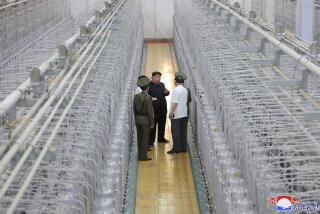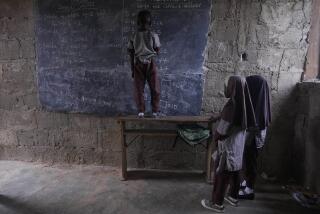A Nation Curses the Dark
- Share via
ONJUNG-RI, North Korea — When the sun drops low in the winter sky, the landscape fades to gray and the squat houses of monochromatic concrete are swallowed up by the night. Not even a dim lightbulb or an oil lamp flickering through a broken windowpane interrupts the expanse of darkness. It is as though this entire village of 3,000 people has disappeared, along with all other signs of human habitation.
This is a typical nighttime scene in rural North Korea, where electricity is in such short supply that few people can light their homes. Even the lighthouse at nearby Kosung harbor doesn’t shine at night. It doesn’t matter much, though, as there’s no fuel for boats -- or for anything else.
Of all the difficulties facing North Korea, the energy shortage is perhaps the most critical. It underlies the crisis over nuclear development and is one of the main factors contributing to chronic famines and the overall dysfunction of the country.
“It is a vicious downward cycle. Everything that North Korea has is decrepit, and they don’t have the electricity to make spare parts to fix it,” said Timothy Savage, who has worked on energy-assistance programs in North Korea with the Nautilus Institute for Security and Sustainable Development, a Berkeley organization that has conducted some of the most detailed studies of this nation’s energy problems.
Savage contrasts the situation in North Korea with underdeveloped countries where households have never relied on electricity.
“This is not like rural Africa,” he said. “North Korea was completely electrified. It is not like they were never part of the modern world. They were kicked out of the modern world.”
In its last detailed study of North Korea’s energy situation, Nautilus estimated that in 2000 the nation had an electricity-generating capacity of about 2 gigawatts at any given time, less than one-third of what it had a decade earlier.
That is less electrical energy for this nation of 22 million people than is consumed by many medium-size American cities.
Put another way, the amount of electricity used by the average North Korean -- including in homes, industries, shops and government buildings -- was less than 4% of that used by an American.
“I’m sure it has not gotten better, and in all probability it has gotten worse,” said David Von Hippel, an energy specialist who was one of the authors of the report.
On Thursday, the North Korean government acknowledged its energy woes in a state news service report, noting that power outages frequently disrupted factories and electric train service.
“If the United States did not kick up a ‘nuclear row’ ... the electricity problem would have already been solved fully in the country,” the Korean Central News Agency said.
The problem is most pressing outside the capital, Pyongyang, in remote stretches of the countryside. Foreigners are seldom permitted to visit rural North Korea -- in part, say diplomats, because the regime is embarrassed by the scarcities. But one can get a glimpse here in the southeastern enclave around Mt. Kumgang, where guided tours are operated from South Korea.
“This area is far from Pyongyang, and it is really suffering. There is less and less electricity every year,” said Kim Young Hyun, a South Korean who manages tourist facilities on the outskirts of Onjung-ri for the Hyundai Asan Corp.
The company has brought in generators and fuel for the tourists, but the village itself remains dark.
Onjung-ri has electricity between five and 10 days a month, and then only for an hour or two at a time. Firewood is piled high on apartment balconies to provide heat and cooking fuel. There appear to be no operating cars or trucks in the village, just an occasional bicycle.
Although there is a large railroad station just outside the village, adorned with a banner praising North Korea’s founder Kim Il Sung, there hasn’t been enough power to run the electrified trains in years.
People walk along the unused track and in the middle of empty roads carrying improbably large parcels.
Nearby, men and women appear to be building a bridge entirely with hand tools. There is no evidence of any heavy machinery in sight.
Kosung, the port town of 50,000, is filled with construction cranes that appear to be rusted in place.
The chockablock apartment buildings that form its skyline are similarly dark at night.
Residents say they feel lucky if the power is on when they return from work in the evenings so that they can use the elevator.
“The electricity comes and goes,” said Park Hyun Il, 28, who works as a tour guide at Mt. Kumgang. “I’m lucky I live on the third floor so I don’t have far to walk.”
“Electricity is essential for the quality of life,” said resident Kim In Joon, 60, who works at another tourist site near the mountain.
“Even our cultural life is suffering because we can’t watch television.”
North Koreans who have fled the country describe using their useless refrigerators to store shoes and tell of heating irons over wood-burning fires. They say many areas get electricity only on major holidays, such as Kim Il Sung’s birthday.
“When the electricity comes on, you’ll hear people shouting with joy like it’s the World Cup,” said Kim Sun Ae, 36, who defected from a village in North Hamgyong province near the Chinese border. “People complained about the electricity all the time.”
The North presents a dramatic contrast to South Korea, where neon and light are in abundance. Satellite photographs of the peninsula show North Korea as a black hole at night, devoid of light except for a few pinpricks around Pyongyang.
President Bush has referred to those photographs as incontrovertible evidence of the failure of the communist regime.
In fact, North Korea specialists say that the energy crisis is the result of both inept leadership and a few unlucky breaks dealt by the turn of history.
Before 1991, North Korea imported most of its oil and natural gas from the Soviet Union at bargain prices.
The collapse of the Eastern Bloc cut off not only fuel but also spare parts for the North’s Soviet-designed power plants. That in turn led to the breakdown of the energy-dependent agricultural industry, which used electrically operated irrigation systems and petroleum-based fertilizers.
“There is a direct causal link between the energy shortage and the food shortages,” says Marcus Noland, a North Korea expert with the Institute for International Economics in Washington. “North Korea was not very well suited to growing food, and they developed an incredibly input-intensive style of agriculture.”
As fuel grew short, tractors broke down when farmers tried to run them by burning corn husk instead of gasoline. The coal-mining industry went into a tailspin because hungry miners had little stamina and coal could not be transported without fuel. Factories stopped working.
North Korea’s hydroelectric plants, another important source of energy after coal, broke down for lack of spare parts. Desperate for bolts and other hardware, people began salvaging parts from electric towers.
“Their power plants are only operating at about 30% of capacity, and of what is generated about 30% is lost because of deteriorating power lines and cables,” said Hong Song Kuk, an infrastructure specialist with South Korea’s Unification Ministry.
The dilapidated state of the power lines is readily apparent from a glance around Onjung-ri. Loose electric wires dangle from rusted utility poles.
As for insulation, few buildings appear to have complete sets of windows.
The North Koreans claim they need nuclear power to revitalize their economy. They blame the United States for their energy crisis and furiously point to the virtual collapse of a 1994 pact, under which the North agreed to end its nuclear program in return for pledges of energy assistance from the U.S. and its allies.
The Bush administration says North Korea is responsible for the failure of the deal because it cheated on its promises to suspend its nuclear effort.
Under the pact, two light-water nuclear reactors -- designed to produce power but not aid in the development of nuclear weapons -- were to be built for North Korea by the end of this year.
“This is why they are so angry. They desperately need the electricity,” said Jang Sung Min, a former aide to South Korean President Kim Dae Jung.
“All their planning was based on the assumption that these reactors would be completed,” Jang said.
Few experts believe, however, that nuclear power is the solution to North Korea’s woes. The 5-megawatt reactor that the regime is in the process of restarting is too small to provide any viable quantity of electricity, and the two larger reactors that had been under construction remain years away from completion.
Some South Koreans are pushing for a plan to run natural gas by pipeline from fields off Sakhalin island in the Russian Far East.
Another idea is for the South to help out by running what is essentially a huge extension cord through the demilitarized zone between the two Koreas, but the poor state of the North’s power grid makes it unlikely that would work.
The Nautilus Institute has recommended that the international community concentrate its efforts on repairing the existing energy infrastructure, increasing energy efficiency and developing alternative energy sources.
While international debate rages over what to do about North Korea, there is consensus that it faces a terrible energy crisis.
If the regime renounces its nuclear ambitions in return for humanitarian assistance, the focus will most likely be on getting the North out of the dark.
More to Read
Sign up for Essential California
The most important California stories and recommendations in your inbox every morning.
You may occasionally receive promotional content from the Los Angeles Times.













